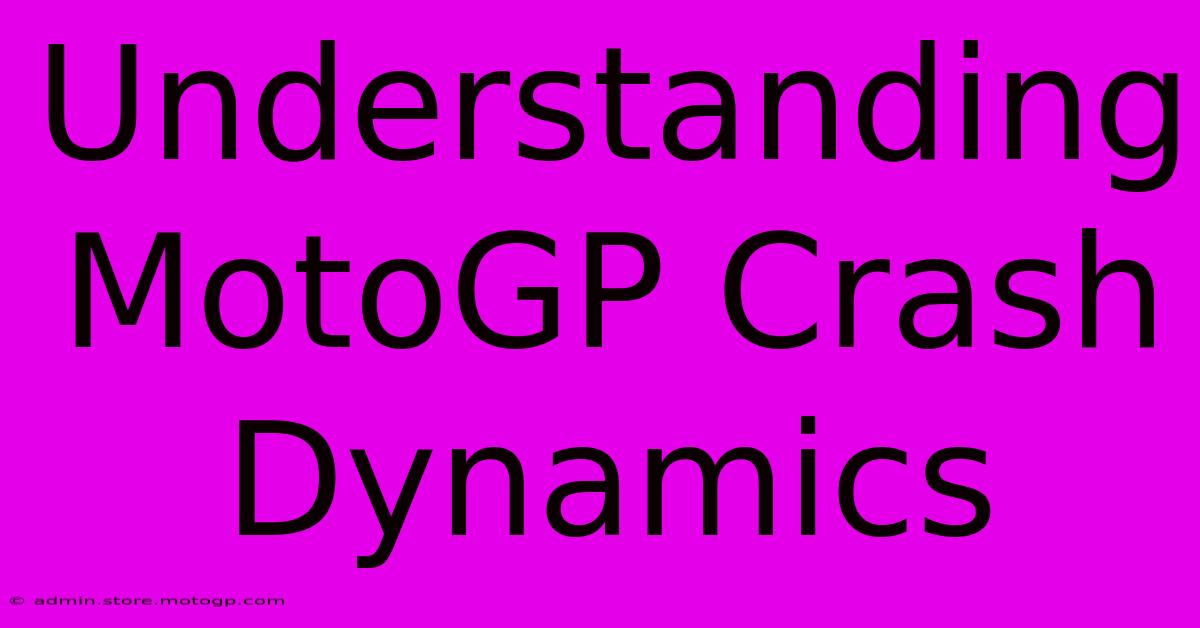Understanding MotoGP Crash Dynamics

Table of Contents
Understanding MotoGP Crash Dynamics: A Deep Dive into High-Speed Impacts
MotoGP, the pinnacle of motorcycle racing, showcases breathtaking speed and skill. However, the inherent risks are undeniable, with crashes a frequent, albeit unfortunate, occurrence. Understanding the dynamics behind these crashes is crucial for improving rider safety, designing safer bikes, and appreciating the incredible feats of these athletes. This article delves into the complex physics and factors contributing to MotoGP crashes.
The Physics of a MotoGP Crash
MotoGP crashes aren't simple tumbles; they're complex events involving high speeds, significant forces, and multiple interacting factors. Let's break down the key elements:
1. Loss of Traction: The Initial Trigger
Most MotoGP crashes originate from a loss of traction. This can stem from several sources:
- Tire Slip: Exceeding the grip limit of the tires, particularly during cornering or acceleration/braking, is a primary cause. This can be influenced by factors like track conditions (wet, oily, or dusty surfaces), tire wear, and rider input.
- Sudden Changes in Grip: Unexpected changes in track surface, like a patch of oil or gravel, can instantly disrupt traction.
- Mechanical Failures: While rare, tire punctures, brake failure, or other mechanical issues can lead to sudden and unpredictable loss of control.
2. The Impact: Forces at Play
Once traction is lost, the ensuing impact is governed by several powerful forces:
- Inertia: A rider and motorcycle continue in their original direction until acted upon by an external force. This often results in high-speed slides or tumbles.
- Angular Momentum: The spinning motion of a motorcycle after a crash is due to angular momentum, which is difficult to arrest quickly.
- Centrifugal Force: During cornering, centrifugal force pushes the bike and rider outwards. A loss of traction amplifies this force, contributing to the severity of the crash.
- Impact Forces: The force of the initial impact with the ground, other bikes, or trackside barriers can cause severe injuries. The energy absorbed by the rider's protective gear plays a critical role in mitigating these forces.
3. The Role of Rider Skill and Technique
While mechanical failures and track conditions play a role, rider skill and technique are paramount in crash avoidance and mitigation:
- Smooth Input: Precise control of throttle, brakes, and steering minimizes the risk of exceeding tire grip limits.
- Body Positioning: Correct body posture allows the rider to better react to changes in grip and maintain control.
- Emergency Procedures: Knowing how to react to a loss of traction—such as counter-steering or smoothly releasing the brakes—can significantly reduce crash severity.
Analyzing MotoGP Crashes: Data and Technology
Understanding MotoGP crashes involves more than just observation; sophisticated data acquisition and analysis are critical:
- Telemetry Data: Sensors on the bikes record speed, acceleration, braking force, lean angle, and other vital parameters, allowing detailed analysis of the events leading up to a crash.
- High-Speed Cameras: Multiple camera angles provide a visual record of the crash sequence, helping identify the contributing factors.
- Crash Simulation: Advanced simulations utilize data and physical models to reconstruct crashes and explore different scenarios, potentially identifying areas for improvement in bike design or safety regulations.
Improving Safety in MotoGP
The continuous pursuit of safety in MotoGP is an ongoing process, with advancements in various areas:
- Improved Protective Gear: Technological advancements in suits, helmets, and other protective equipment are constantly improving rider protection.
- Track Safety: Track designs, run-off areas, and barrier systems are continually evaluated and improved to mitigate crash severity.
- Bike Design: Developments in chassis design, electronics, and safety features aim to enhance stability and reduce the risk of crashes.
- Rider Training: Rigorous training programs focus on developing advanced riding skills, emergency response techniques, and physical fitness to enhance rider safety.
Conclusion: The Ongoing Evolution of Safety
MotoGP crashes are complex events with multiple interconnected causes. By understanding the physics, analyzing data, and employing innovative safety measures, the sport continuously strives to minimize risks while maintaining the thrilling spectacle of high-speed racing. The relentless pursuit of safety is a testament to the commitment to protecting these extraordinary athletes.

Thank you for visiting our website wich cover about Understanding MotoGP Crash Dynamics. We hope the information provided has been useful to you. Feel free to contact us if you have any questions or need further assistance. See you next time and dont miss to bookmark.
Featured Posts
-
Leave The Driving To Us F1 Shuttle To Cota
Feb 18, 2025
-
Cota Parking Avoid The Crowds And Get Parked Quickly
Feb 18, 2025
-
Yamaha Moto Gp Racing The Comeback Kid Team News Confirmed
Feb 18, 2025
-
Top Speed Moto Gp Bike The Ultimate Speed Demons
Feb 18, 2025
-
Moto Gp Arcade Experience The Evolution Of Racing
Feb 18, 2025
